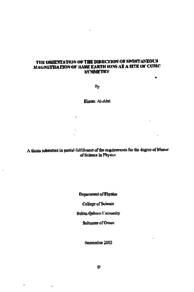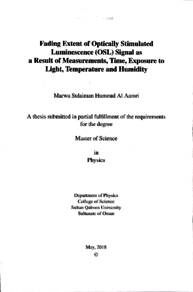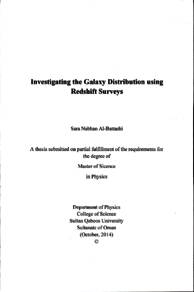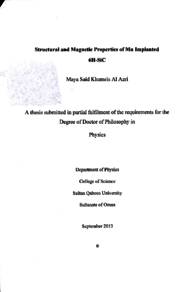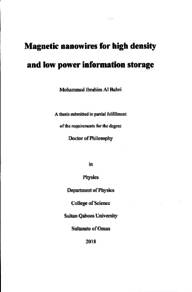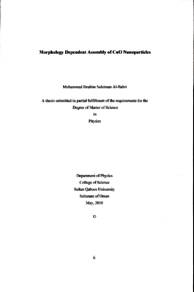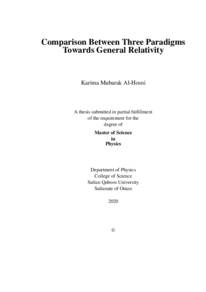Document
The orientation of the direction of spontaneous magnetisation of rare earth ions at a site of cubic symmetry
Publisher
Sultan Qaboos University
Gregorian
2003
Language
English
Subject
English abstract
The direction of spontaneous magnetization in rare-earth compounds and alloys is the result of a delicate balance between the magnetic and the electrostatic crystal field interactions on one hand and the relative strengths of the various terms in the crystal field Hamiltonian. At a site of cubic symmetry there are only two terms in the crystal field (fourth order and sixth order); Lea Leask and Wolf (1962) have introduced the parameter x to quantify the relative strength of these two terms. In the present work a parameter R is introduced to quantify the relative strengths of the magnetic and the electrostatic interactions. Diagrams of the computed direction of spontaneous magnetization as a function of the parameters R and x for all the allowed values of J between 3 and 8 have been obtained. It is found that, in agreement to what is observed experimentally, the direction of spontaneous magnetization is in general along one of the principal crystallographic orientations.
For all values of J investigated each of the three orientations <100>, <110>, and <111> can be the direction of spontaneous magnetization for some values of the parameters x and R. It is found that at the boundaries between the regions in the {R,x} parameter space there are three possible types of behaviors for the direction of spontaneous magnetization. The direction of spontaneous magnetization can either rotate continuously from one crystallographic orientation to the other or display a sudden jump from one orientation to the other at a critical value of {R, x}. Two One situations have been observed in the latter case. At the critical value the plane containing the two crystallographic orientations involved becomes a degenerate plane or, at the critical value the two orientations are degenerate and there is a region close to the boundary where there is an unstable equilibrium orientation for the direction of spontaneous magnetization.
Member of
Resource URL
Arabic abstract
أن متجه المغنطة التلقائية في مركبات وسبائك المعادن الأرضية النادرة يعتمد على التأثير المتبادل بين التفاعلات المغناطيسية، والتفاعلات الالكتروستاتية داخل البلورة . ففي حالة التمائل النقطي عند المكعب تم تمثيل التفاعلات الالكتروستاتية بحدين من الدرجة الرابعة والسادسة، حيث تم تمثيل القوة النسبية بينهما في الورقة البحثية لكلا من لي، وليسك، وولف باستخدام الرمز x . في هذا المشروع البحثي ادخل المقدار R لتحديد العلاقة النسبية بين التفاعلات المغناطيسية، والتفاعلات الالكتروستاتية داخل البلورة. العلاقة بين هذين المقدارین. ( R ,x ) تم تمثيلها برسوم بيانية لقيم مختلفة من كمية التحرك الزواي الكلي من القيمة 3 الى القيمة 8. باستخدام النتائج التجريبية وجد ان اتجاه المغناطيسية التلقائية يتجه نحو أحد المحاور البلورية الأساسية. لذلك الجميع قيم كمية التحرك الزاوي المختارة للبحث والاستقصاء في هذا المشروع كان متجه الكمية يشير نحو أحد المحاور البلورية التالية : (100 ) أو ( 110 ) أو( 111) من جهة أخرى في العلاقة البيانية ( R , x ) وجد عند المنطقة الحدودية بين منطقتين - نو اتجاهين مختلفين في متجه محصلة اتجاه العزم المغناطيسي أن هذا المتجه يتخذ ثلاثة أنواع من السلوك : إما أن يدور هذا المتجه على نحو متصل من منطقة ذات اتجاه بلوري إلى منطقة ذات اتجاه بلوري آخر، أو يقفز فجأة من منطقة إلى أخرى في المنطقة الحرجة من الإطار البياني ل( R , x ) . وفي السلوك الأخير يتخذ أحد المسارين التاليين: عند المنطقة الحدودية حيث يوجد منطقتين ذوات اتجاه بلوري مختلف يكون عند كل منهما متجه العزم المغناطيسي مستقر، ولكن بينهما يوجد منطقة غير مستقرة للاتجاه المغناطيسي. وفي النوع الثالث عند قيمة معينة للمقدار x بالمنطقة الحدودية اتجاهين بلوریین مختلفين لهما نفس مستوی الطاقة.
Category
Theses and Dissertations

